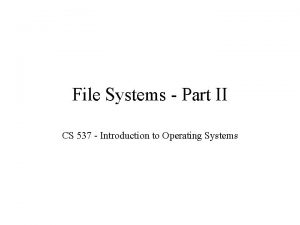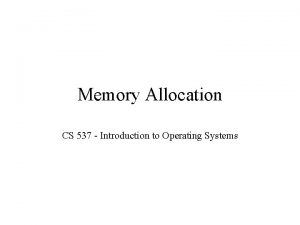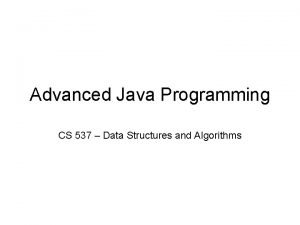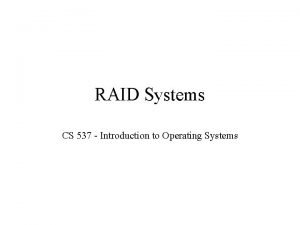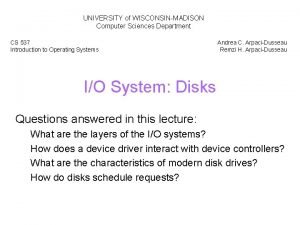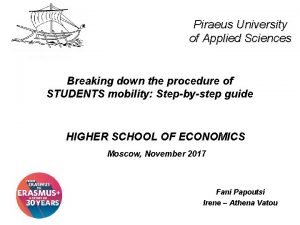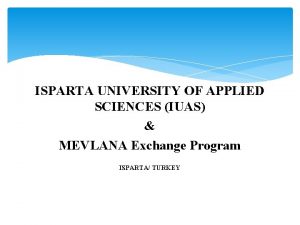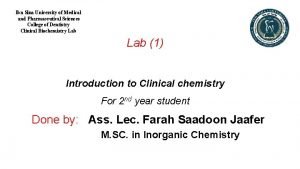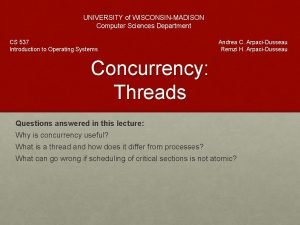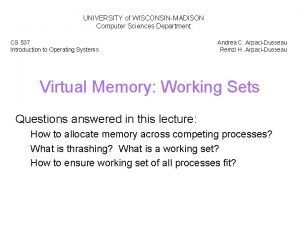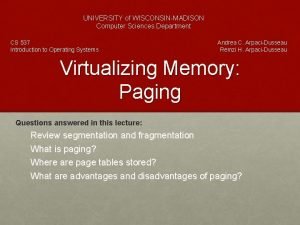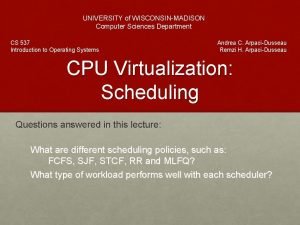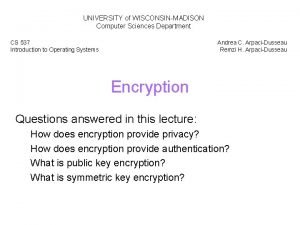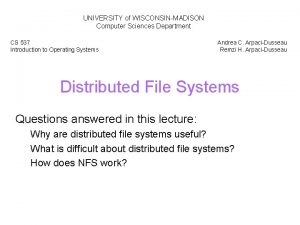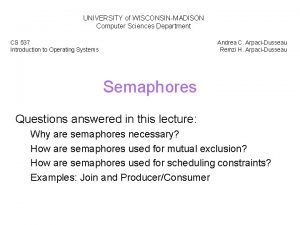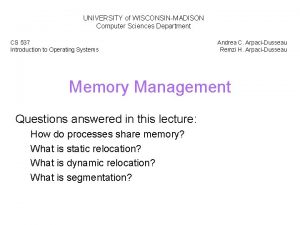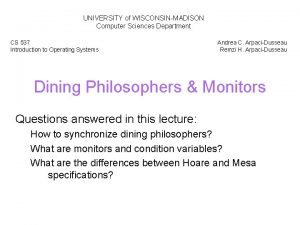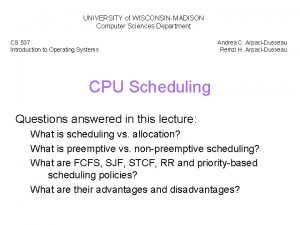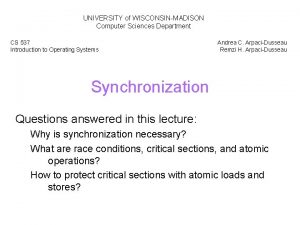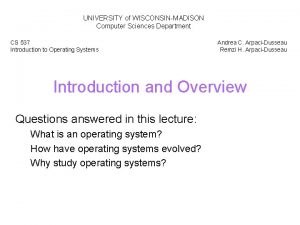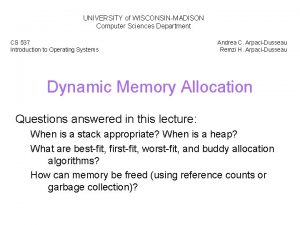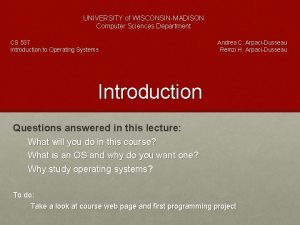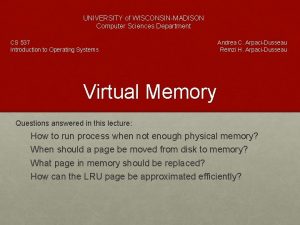UNIVERSITY of WISCONSINMADISON Computer Sciences Department CS 537



















- Slides: 19

UNIVERSITY of WISCONSIN-MADISON Computer Sciences Department CS 537 Introduction to Operating Systems Andrea C. Arpaci-Dusseau Remzi H. Arpaci-Dusseau Processes Questions answered in this lecture: What is a process? How does the dispatcher context-switch between processes? How does the OS create a new process?

What is a Process? 1. 2. Process: An execution stream in the context of a process state Execution stream 1. 2. 3. 4. Stream of executing instructions Running piece of code Sequential sequence of instructions “thread of control” Process state 1. 2. Everything that the running code can affect or be affected by Registers 1. General-purpose, floating point, status, program counter, stack pointer 3. Address space 1. Everything process can address through memory 2. Represented by array of bytes 3. Heap, stack, and code

Processes vs. Programs A process is different than a program • Program: Static code and static data • Process: Dynamic instance of code and data No one-to-one mapping between programs and processes • Can have multiple processes of the same program Example: many users can run “ls” at the same time • One program can invoke multiple processes Example: “make” runs many processes to accomplish its work

Processes vs. Threads A process is different than a thread Thread: “Lightweight process” (LWP) • An execution stream that shares an address space • Multiple threads within a single process Example: • Two processes examining memory address 0 xffe 84264 see different values (I. e. , different contents) • Two threads examining memory address 0 xffe 84264 see same value (I. e. , same contents)

System Classifications All systems support processes, but the number varies Uniprogramming: Only one process resident at a time • Examples: First systems and DOS for PCs • Advantages: Runs on all hardware • Disadvantages: Not convenient for user and poor performance Multiprogramming: Multiple processes resident at a time (or, multitasking) • Note: Different than multiprocessing – Multiprocessing: Systems with multiple processors • Examples: Unix variants, Windows. NT • Advantages: Better user convenience and system performance • Disadvantages: Complexity in OS

Multiprogramming OS requirements for multiprogramming • Mechanism – To switch between processes – To protect processes from one another • Policy – To decide which process to schedule Separation of policy and mechanism • Reoccuring theme in OS • Policy: Decision-maker to optimize some workload performance metric – Which process when? – Process Scheduler: Future lecture • Mechanism: Low-level code that implements the decision – How? – Process Dispatcher: Today’s lecture

Dispatch Mechanism OS runs dispatch loop while (1) { run process A for some time-slice stop process A and save its context load context of another process B } Context-switch Question 1: How does dispatcher gain control? Question 2: What execution context must be saved and restored?

Q 1: Hardware for Multiprogramming Must differentiate application process and OS Hardware support • Bit in status word designates whether currently running in user or system mode • System mode (or privileged or supervisor) allows functionality – Execution of special instructions (e. g. , access hardware devices) – Access to all of memory – Change stack pointer • Usage – Applications run in user mode – OS runs in system mode

Q 1: Entering system mode How does OS get control? 1) Synchronous interrupts, or traps 1. Event internal to a process that gives control to OS 2. Examples: System calls, page faults (access page not in main memory), or errors (illegal instruction or divide by zero) 2) Asynchronous interrupts 1. Events external to a process, generated by hardware 2. Examples: Characters typed, or completion of a disk transfer 1. How are interrupts handled? 1. Each type of interrupt has corresponding routine (handler or interrupt service routine (ISR) 2. Hardware saves current process and passes control to ISR

Q 1: How does Dispatcher run? Option 1: Cooperative Multi-tasking • Trust process to relinquish CPU through traps – Trap: Event internal to process that gives control to OS – Examples: System call, page fault (access page not in main memory), or error (illegal instruction or divide by zero) • Disadvantages: Processes can misbehave – By avoiding all traps and performing no I/O, can take over entire machine – Only solution: Reboot! • Not performed in modern operating systems

Q 1: How does Dispatcher run? Option 2: True Multi-tasking • Guarantee OS can obtain control periodically • Enter OS by enabling periodic alarm clock – Hardware generates timer interrupt (CPU or separate chip) – Example: Every 10 ms • User must not be able to mask timer interrupt • Dispatcher counts interrupts between context switches – Example: Waiting 20 timer ticks gives 200 ms time slice – Common time slices range from 10 ms to 200 ms

Q 2: Process States Each process is in one of three modes: • Running: On the CPU (only one on a uniprocessor) • Ready: Waiting for the CPU • Blocked (or asleep): Waiting for I/O or synchronization to complete Running Transitions? Blocked Ready

Q 2: Tracking Processes OS must track every process in system Each process identified by unique Process ID (PID) OS maintains queues of all processes • Ready queue: Contains all ready processes • Event queue: One logical queue per event (e. g. , disk I/O and locks) – Contains all processes waiting for that event to complete

Q 2: What Context must be Saved? Dispatcher must track context of process when not running • Save context in process control block (PCB) (or, process descriptor) What information is stored in PCB? • • PID Process state (I. e. , running, ready, or blocked) Execution state (all registers, PC, stack ptr) Scheduling priority Accounting information (parent and child processes) Credentials (which resources can be accessed, owner) Pointers to other allocated resources (e. g. , open files)

Q 2: Context-Switch Implementation Basic idea: Save all registers to PCB in memory • Tricky: Must execute code without using registers • Machine-dependent code (written in assembly) – Different for x 86, SPARC, MIPS, etc. Requires special hardware support • Hardware saves process PC and PSR on interrupts • CISC: Single instruction saves all registers onto stack • RISC: Agreement to keep some registers empty – Alpha and SPARC: Shadow registers – MIPS: Two general-purpose registers are scratch, avoided by compiler How long does a context-switch take? • 10 s of microseconds

Multiprogramming and Memory Does OS need to save all of memory between processes? Option 1: Save all of memory to disk • Example: Alto, early personal workstation • Disadvantage: Very time consuming • How long to save a 10 MB process to disk? Option 2: Trust next process to not overwrite memory • Example: Early multiprogramming in PCs and Macs (single user) • Disadvantage: Very hard to track down bugs Option 3: Protect memory (and files) from next process • Requires hardware support • Investigate later in course

Process Creation Two ways to create a process • Build a new empty process from scratch • Copy an existing process and change it appropriately Option 1: New process from scratch • Steps – Load specified code and data into memory; Create empty call stack – Create and initialize PCB (make look like context-switch) – Put process on ready list • Advantages: No wasted work • Disadvantages: Difficult to setup process correctly and to express all possible options – Process permissions, where to write I/O, environment variables – Example: Windows. NT has call with 10 arguments

Process Creation Option 2: Clone existing process and change • Example: Unix fork() and exec() – Fork(): Clones calling process – Exec(char *file): Overlays file image on calling process • Fork() – – Stop current process and save its state Make copy of code, data, stack, and PCB Add new PCB to ready list Any changes needed to PCB? • Exec(char *file) – Replace current data and code segments with those in specified file • Advantages: Flexible, clean, simple • Disadvantages: Wasteful to perform copy and then overwrite of memory

Unix Process Creation How are Unix shells implemented? While (1) { Char *cmd = getcmd(); Int retval = fork(); If (retval == 0) { // This is the child process // Setup the child’s process environment here // E. g. , where is standard I/O, how to handle signals? exec(cmd); // exec does not return if it succeeds printf(“ERROR: Could not execute %sn”, cmd); exit(1); } else { // This is the parent process; Wait for child to finish int pid = retval; wait(pid); } }
 Human science tok
Human science tok Columbia university department of computer science
Columbia university department of computer science Hymn 537
Hymn 537 Cs 537
Cs 537 Cs 537
Cs 537 Cs 537
Cs 537 Cs 537
Cs 537 Cs 537
Cs 537 537-317-757
537-317-757 Van hall larenstein, university of applied sciences
Van hall larenstein, university of applied sciences University of applied sciences vaasa
University of applied sciences vaasa Oulu university of applied sciences
Oulu university of applied sciences Hswt student service
Hswt student service Kodolányi jános university of applied sciences
Kodolányi jános university of applied sciences Western norway university of applied sciences
Western norway university of applied sciences Piraeus university of applied sciences
Piraeus university of applied sciences Jade university of applied sciences
Jade university of applied sciences Iuas
Iuas Serum vs plasma
Serum vs plasma Eberswalde university of applied sciences
Eberswalde university of applied sciences



